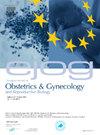Primary infertile couples share more HLA alleles than expected by chance
IF 2.1
4区 医学
Q2 OBSTETRICS & GYNECOLOGY
European journal of obstetrics, gynecology, and reproductive biology
Pub Date : 2025-02-24
DOI:10.1016/j.ejogrb.2025.02.053
引用次数: 0
Abstract
Objective
To examine whether the rate of HLA similarity among 609 primarily infertile couples is higher than would be expected by chance.
Design
Clinical Trial.
Subjects
609 primary infertile couples (mean age women: 34.35 years, men: 37.59 years) were recruited before undergoing IVF or ICSI therapy. Couples with former pregnancies, tubal factor, azoospermia or donor therapies were excluded.
Intervention
For each of the partners, exons encoding the corresponding antigen recognition sites of HLA-A, −B, −C, −DRB1, −DQB1, and −DPB1 were sequenced by using next-generation sequencing. HLA similarity between partners was determined based on the probability of homozygous offspring and the observed probability of heterozygous offspring in the sample of primary infertile couples was comparted to the probability for random pairing using bootstrapping.
Main outcome measures
HLA similarity of infertile couples compared to randomly assigned couples.
Results
In each of the loci, infertile pairs shared more alleles than expected by chance. This result was significant for all HLA class 2 loci (−DRB1, −DQB1, −DPB1), as well as for the HLA class I locus −C, while HLA-A and −B showed a nonsignificant trend towards higher similarity.
Conclusion
These data suggest that HLA similarity between couples relates to primary infertility.
求助全文
约1分钟内获得全文
求助全文
来源期刊
CiteScore
4.60
自引率
3.80%
发文量
898
审稿时长
8.3 weeks
期刊介绍:
The European Journal of Obstetrics & Gynecology and Reproductive Biology is the leading general clinical journal covering the continent. It publishes peer reviewed original research articles, as well as a wide range of news, book reviews, biographical, historical and educational articles and a lively correspondence section. Fields covered include obstetrics, prenatal diagnosis, maternal-fetal medicine, perinatology, general gynecology, gynecologic oncology, uro-gynecology, reproductive medicine, infertility, reproductive endocrinology, sexual medicine and reproductive ethics. The European Journal of Obstetrics & Gynecology and Reproductive Biology provides a forum for scientific and clinical professional communication in obstetrics and gynecology throughout Europe and the world.

 求助内容:
求助内容: 应助结果提醒方式:
应助结果提醒方式:


